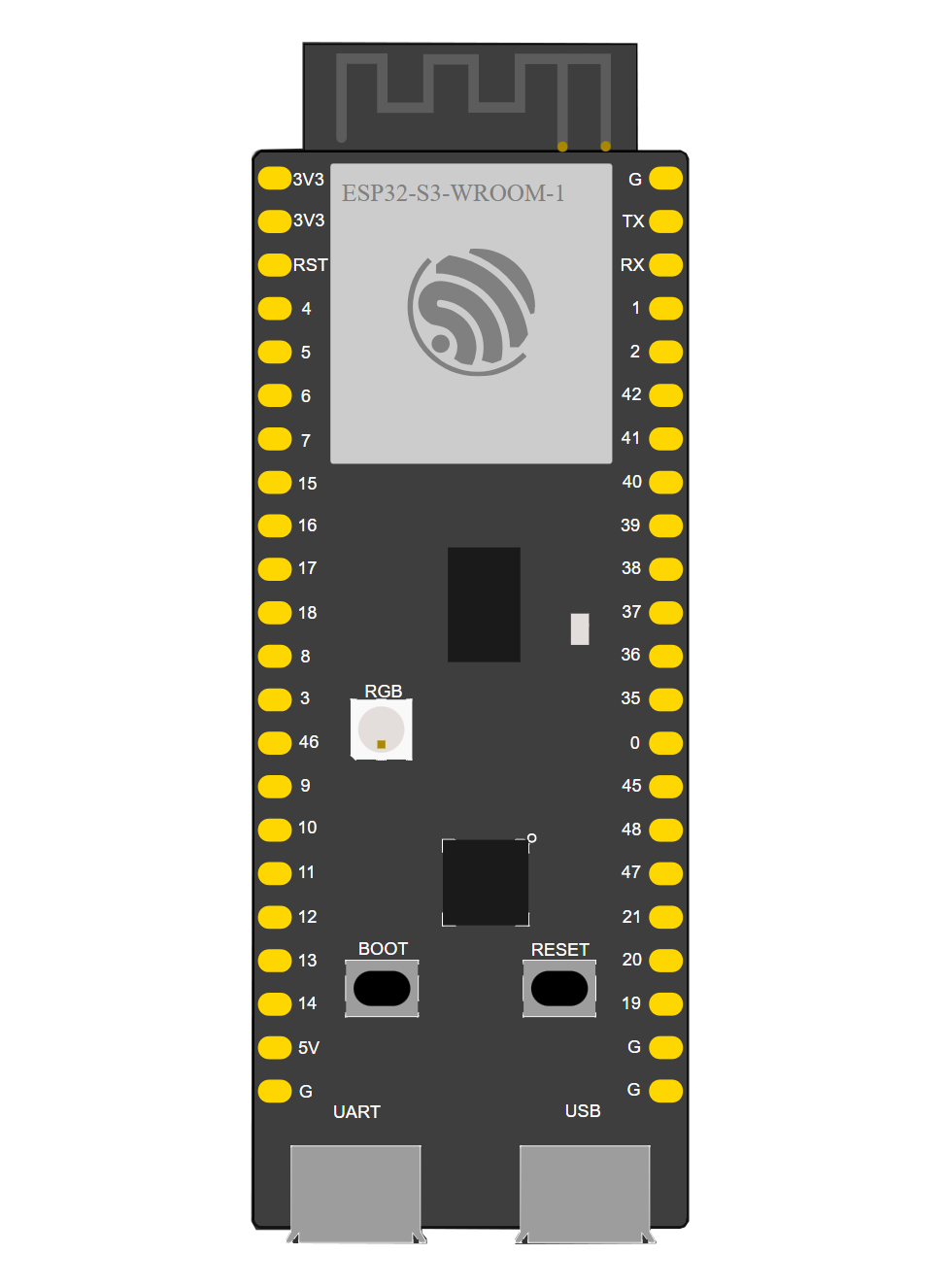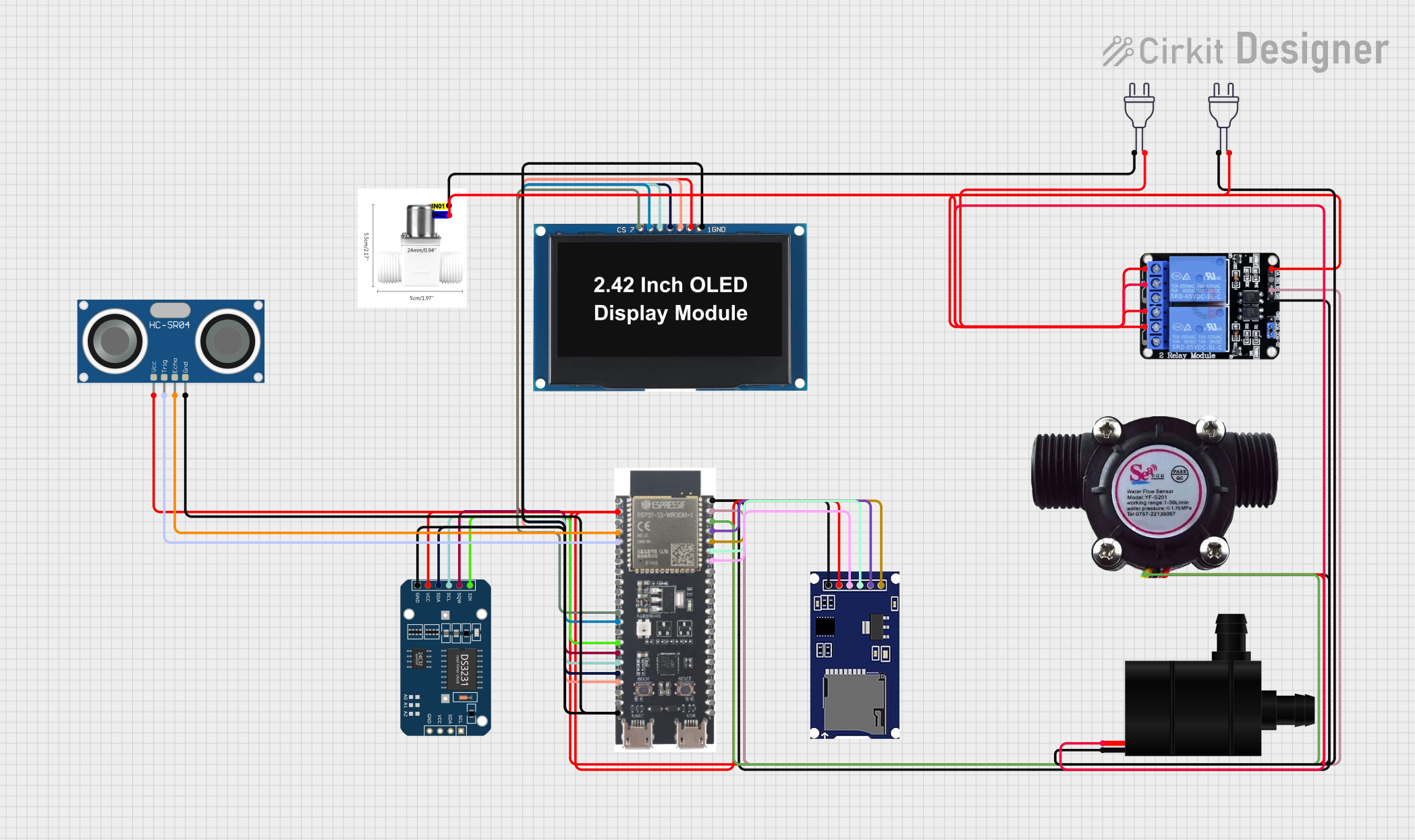
How to Use ESP32-S3: Examples, Pinouts, and Specs

 Design with ESP32-S3 in Cirkit Designer
Design with ESP32-S3 in Cirkit DesignerIntroduction
The ESP32-S3 by Automata (Part ID: ESP32) is a powerful, low-power system on a chip (SoC) designed for Internet of Things (IoT) applications. It integrates both Wi-Fi and Bluetooth capabilities, making it a versatile choice for wireless communication. With its dual-core processor, extensive GPIO pins, and support for a wide range of peripherals, the ESP32-S3 is ideal for smart devices, home automation, wearables, and other applications requiring efficient wireless connectivity.
Explore Projects Built with ESP32-S3

 Open Project in Cirkit Designer
Open Project in Cirkit Designer
 Open Project in Cirkit Designer
Open Project in Cirkit Designer
 Open Project in Cirkit Designer
Open Project in Cirkit Designer
 Open Project in Cirkit Designer
Open Project in Cirkit DesignerExplore Projects Built with ESP32-S3

 Open Project in Cirkit Designer
Open Project in Cirkit Designer
 Open Project in Cirkit Designer
Open Project in Cirkit Designer
 Open Project in Cirkit Designer
Open Project in Cirkit Designer
 Open Project in Cirkit Designer
Open Project in Cirkit DesignerCommon Applications
- Smart home devices (e.g., smart lights, thermostats)
- Wearable technology
- Industrial IoT systems
- Wireless sensor networks
- Robotics and automation
- Real-time data monitoring and logging
Technical Specifications
The ESP32-S3 is packed with features that make it suitable for a variety of applications. Below are its key technical specifications:
| Parameter | Value |
|---|---|
| Processor | Dual-core Xtensa® LX7, up to 240 MHz |
| Wireless Connectivity | Wi-Fi 802.11 b/g/n (2.4 GHz), Bluetooth 5.0 LE |
| Flash Memory | Up to 16 MB (external flash supported) |
| SRAM | 512 KB internal, with support for external PSRAM |
| GPIO Pins | 45 GPIOs (multiplexed with other functions) |
| Operating Voltage | 3.0V to 3.6V |
| Power Consumption | Ultra-low power modes available (deep sleep current: ~10 µA) |
| Peripherals | SPI, I2C, I2S, UART, ADC, DAC, PWM, CAN, RMT, and more |
| Security Features | AES, SHA, RSA, HMAC, Digital Signature, Secure Boot, Flash Encryption |
| Operating Temperature | -40°C to +85°C |
| Package | QFN48 (7x7 mm) |
Pin Configuration
The ESP32-S3 has a rich set of GPIO pins and peripherals. Below is a summary of the pin configuration:
| Pin Name | Function | Description |
|---|---|---|
| GPIO0 | Input/Output, Boot Mode | Used for boot mode selection during startup |
| GPIO1-45 | General Purpose I/O | Configurable for digital I/O, ADC, DAC, PWM, etc. |
| EN | Enable | Chip enable pin; active high |
| VDD | Power Supply | 3.3V power input |
| GND | Ground | Ground connection |
| TXD0/RXD0 | UART0 TX/RX | Default UART for serial communication |
| ADC1/ADC2 | Analog Input | 12-bit ADC channels for analog signal measurement |
| SPI Pins | SPI Interface | SPI_CLK, SPI_MOSI, SPI_MISO, SPI_CS for SPI communication |
| I2C Pins | I2C Interface | I2C_SCL, I2C_SDA for I2C communication |
| DAC1/DAC2 | Digital-to-Analog Converter | 8-bit DAC channels for analog signal output |
Note: Some GPIO pins are multiplexed with other functions. Refer to the ESP32-S3 datasheet for detailed pin assignments.
Usage Instructions
The ESP32-S3 is highly versatile and can be used in a variety of circuits. Below are the steps to get started:
Basic Circuit Setup
- Power Supply: Connect the VDD pin to a 3.3V power source and GND to ground.
- Boot Mode: Connect GPIO0 to GND during power-up to enter bootloader mode for programming.
- UART Communication: Use TXD0 and RXD0 for serial communication with a computer or microcontroller.
- Peripherals: Connect peripherals (e.g., sensors, actuators) to the appropriate GPIO pins.
Programming with Arduino IDE
The ESP32-S3 can be programmed using the Arduino IDE. Follow these steps:
- Install the ESP32 Board Support Package in the Arduino IDE.
- Select the correct board (
ESP32-S3) and port from the Tools menu. - Write your code and upload it to the ESP32-S3.
Example Code: Blinking an LED
// This example demonstrates how to blink an LED connected to GPIO2 on the ESP32-S3.
#define LED_PIN 2 // Define the GPIO pin where the LED is connected
void setup() {
pinMode(LED_PIN, OUTPUT); // Set the LED pin as an output
}
void loop() {
digitalWrite(LED_PIN, HIGH); // Turn the LED on
delay(1000); // Wait for 1 second
digitalWrite(LED_PIN, LOW); // Turn the LED off
delay(1000); // Wait for 1 second
}
Important Considerations
- Voltage Levels: Ensure all connected peripherals operate at 3.3V logic levels to avoid damage.
- Power Supply: Use a stable power source to prevent unexpected resets or malfunctions.
- GPIO Usage: Avoid using GPIOs reserved for internal functions (e.g., GPIO6-11 for flash memory).
- Antenna Placement: For optimal wireless performance, ensure the onboard antenna is not obstructed.
Troubleshooting and FAQs
Common Issues
ESP32-S3 Not Detected by Computer
- Ensure the USB cable is functional and supports data transfer.
- Check if the correct COM port is selected in the Arduino IDE.
- Verify that the ESP32-S3 is in bootloader mode (GPIO0 connected to GND during power-up).
Program Upload Fails
- Confirm that the correct board and port are selected in the Arduino IDE.
- Check for loose connections or insufficient power supply.
- Ensure no other application is using the COM port.
Wi-Fi or Bluetooth Not Working
- Verify that the antenna is unobstructed and properly positioned.
- Check the Wi-Fi credentials or Bluetooth pairing settings in your code.
Tips for Troubleshooting
- Use a multimeter to check power supply voltage and continuity of connections.
- Monitor the serial output for error messages or debugging information.
- Update the ESP32 Board Support Package in the Arduino IDE to the latest version.
FAQs
Q: Can the ESP32-S3 operate on battery power?
A: Yes, the ESP32-S3 supports ultra-low power modes, making it suitable for battery-powered applications.
Q: How many devices can the ESP32-S3 connect to via Bluetooth?
A: The ESP32-S3 supports Bluetooth 5.0 LE, allowing multiple simultaneous connections depending on the application.
Q: Can I use the ESP32-S3 with MicroPython?
A: Yes, the ESP32-S3 is compatible with MicroPython. You can flash the MicroPython firmware to the chip and program it using Python.
Q: What is the maximum Wi-Fi range of the ESP32-S3?
A: The Wi-Fi range depends on environmental factors, but it typically covers up to 100 meters in open space.
Q: Is the ESP32-S3 compatible with ESP-IDF?
A: Yes, the ESP32-S3 is fully supported by the ESP-IDF (Espressif IoT Development Framework).
By following this documentation, you can effectively integrate the ESP32-S3 into your projects and troubleshoot common issues.